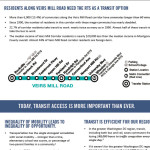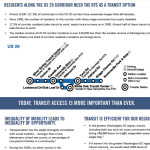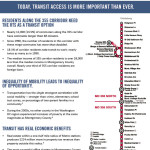
Fact sheet: Benefits of Rapid Transit for Montgomery’s Veirs Mill Rd corridor
RESIDENTS ALONG VEIRS MILL ROAD NEED THE RTS AS A TRANSIT OPTION
• More than 6,000 (15.4%) of commuters along the Veirs Mill Road corridor have commutes longer than 60 minutes.
• Since 1990, the number of residents in this corridor with these mega-commutes has nearly doubled.
• 22.7% of corridor residents take transit to work: nearly twice as many as in 1990. Almost half of these transit riders
take the bus to work.
• The median income of Veirs Mill Corridor residents is nearly $20,000 less than the median income in Montgomery
County overall. Almost 44% of Veirs Mill Road corridor residents are foreign-born.

Fact sheet: Benefits of Rapid Transit for Montgomery’s US-29 corridor
RESIDENTS ALONG THE US 29 CORRIDOR NEED THE RTS AS A TRANSIT OPTION
• Almost 9,500 (17.2%) of commuters in the US 29 corridor have commutes longer than 60 minutes.
• Since 1990, the number of residents in this corridor with these mega-commutes has nearly doubled.
• 17.5% of corridor residents take transit to work: nearly twice as many as in 1990. Almost half of these transit riders
take the bus to work

Fact sheet: Benefits of Rapid Transit for Montgomery’s 355 corridor
Today, transit access is more important than ever. Residents along the 355 corridor need the RTS as a transit option.
• Nearly 12,000 (14.5%) of commuters along the 355 corridor have commutes longer than 60 minutes.
• Since 1990, the number of residents in this corridor with these mega-commutes has more than doubled.
• 18.1% of corridor residents take transit to work: nearly twice as many as in 1990.
• The median income of 355 corridor residents is over $8,000 less than the median income in Montgomery County overall. Nearly one t...
Fact Sheet: What You Need To Know About DC’s Inclusionary Zoning Program
DC adopted its Inclusionary Zoning policy in 2006, finalized regulations in 2009, and brought the first units to the market in 2011. Now more than 1,200 permanently affordable IZ units are in the pipeline. Factsheet-on-Making-IZ-Affordable_2-23-16Download
